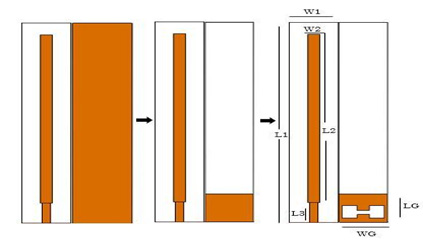Transferencia de energía inalámbrica a través de acoplamiento mutuo usando antenas monopolo
Wireless power transfer through mutual coupling using monopole antennas
Barra lateral del artículo

Términos de la licencia (VER)

Esta obra está bajo una licencia internacional Creative Commons Atribución-NoComercial-SinDerivadas 4.0.
Declaración del copyright
Los autores ceden en exclusiva a la Universidad EIA, con facultad de cesión a terceros, todos los derechos de explotación que deriven de los trabajos que sean aceptados para su publicación en la Revista EIA, así como en cualquier producto derivados de la misma y, en particular, los de reproducción, distribución, comunicación pública (incluida la puesta a disposición interactiva) y transformación (incluidas la adaptación, la modificación y, en su caso, la traducción), para todas las modalidades de explotación (a título enunciativo y no limitativo: en formato papel, electrónico, on-line, soporte informático o audiovisual, así como en cualquier otro formato, incluso con finalidad promocional o publicitaria y/o para la realización de productos derivados), para un ámbito territorial mundial y para toda la duración legal de los derechos prevista en el vigente texto difundido de la Ley de Propiedad Intelectual. Esta cesión la realizarán los autores sin derecho a ningún tipo de remuneración o indemnización.
La autorización conferida a la Revista EIA estará vigente a partir de la fecha en que se incluye en el volumen y número respectivo en el Sistema Open Journal Systems de la Revista EIA, así como en las diferentes bases e índices de datos en que se encuentra indexada la publicación.
Todos los contenidos de la Revista EIA, están publicados bajo la Licencia Creative Commons Atribución-NoComercial-NoDerivativa 4.0 Internacional
Licencia
![]()
Esta obra está bajo una Licencia Creative Commons Atribución-NoComercial-NoDerivativa 4.0 Internacional
Contenido principal del artículo
Resumen
La transferencia de energía inalámbrica mediante el acoplamiento inductivo de campo cercano. se ha empleado en una serie de aplicaciones, entre ellas carga inalámbrica de dispositivos electrónicos y la alimentación de dispositivos biomédicos implantados. En estas aplicaciones, la energía se transfiere a través de distancias cortas, que son mucho más pequeñas que la longitud de onda de la operación. En estos sistemas, la eficiencia de la transferencia de potencia del enlace está relacionada de forma inversa con el rango de operación. Este artículo se centra en el diseño y la investigación de un par de antenas de microcinta de iguales dimensiones, una de estas es excitada por un pulso emitido usando GNU Radio software y USRP 2901. El par de dispositivos propuesto consta de dos monopolos con tierra defectuosa los tamaños, de 16 mm × 116 mm, que actúan como transmisor y receptor respectivamente. Los dispositivos se han diseñado, simulado y optimizados utilizando el software CST Microwave Studio. Los resultados de la corriente superficial de los dispositivos acoplados indican una buena densidad de corriente en un rango de distancia de 10 mm a 50 mm.
Descargas
Detalles del artículo
Referencias (VER)
Ammann, M. J., and Zhi Ning Chen. 2003. “Wideband Monopole Antennas for Multi-Band Wireless Systems.” IEEE Antennas and Propagation Magazine 45(2): 146–50. https://doi.org/10.1109/map.2003.1203133
Anob, P. V., K. P. Ray, and G. Kumar. 2001. “Wideband Orthogonal Square Monopole Antennas with Semi-Circular Base.” IEEE Antennas and Propagation Society, AP-S International Symposium (Digest) 3: 294–97. https://doi.org/10.1109/aps.2001.960090
Burrus, C A A T, and T Bell Laboratories. 1993. “M. Hammoud, P. Poey and F. Colombel.” 29(4). https://doi.org/10.1049/el:19930272
Chhawchharia, Saransch et al. 2018. “Investigation of Wireless Power Transfer Applications with a Focus on Renewable Energy.” Renewable and Sustainable Energy Reviews 91(April): 888–902. https://doi.org/10.1016/j.rser.2018.04.101
Da Silva, Erik Farias, Alfredo Gomes Neto, and Custódio Peixeiro. 2019. “Fast and Accurate Rectenna Design Method.” IEEE Antennas and Wireless Propagation Letters 18(5): 886–90. https://doi.org/10.1109/lawp.2019.2904795
Feng, Junjie, Qiang Li, and Fred C. Lee. 2018. “Coil and Circuit Design of Omnidirectional Wireless Power Transfer System for Portable Device Application.” 2018 IEEE Energy Conversion Congress and Exposition, ECCE 2018: 914–20. https://doi.org/10.1109/ecce.2018.8557465
Kamo, Bexhet, Shkelzen Cakaj, Vladi Koliçi, and Erida Mulla. 2012. “Simulation and Measurements of VSWR for Microwave Communication Systems.” Network and System Sciences 5: 767–73. http://dx.doi.org/10.4236/ijcns.2012.511080PublishedOnlineNovember2012 (April 14, 2021). https://doi.org/10.4236/ijcns.2012.511080
Khandelwal, Mukesh Kumar, Binod Kumar Kanaujia, and Sachin Kumar. 2017. “Defected Ground Structure: Fundamentals, Analysis, and Applications in Modern Wireless Trends.” International Journal of Antennas and Propagation 2017. https://doi.org/10.1155/2017/2018527
Kim, Hongseok et al. 2016. “Coil Design and Measurements of Automotive Magnetic Resonant Wireless Charging System for High-Efficiency and Low Magnetic Field Leakage.” : 1–18. https://doi.org/10.1109/wpt.2015.7140180
Kim, Youngsub, Young Joong Yoon, Jinwoo Shin, and Joonho So. 2014. “X-Band Printed Rectenna Design and Experiment for Wirelss Power Transfer.” In IEEE Wireless Power Transfer Conference 2014, IEEE WPTC 2014, IEEE Computer Society, 292–95. https://doi.org/10.1109/wpt.2014.6839566
Li, Cheng Jyun, and Tai Cheng Lee. 2014. “2.4-GHz High-Efficiency Adaptive Power.” IEEE Transactions on Very Large Scale Integration (VLSI) Systems 22(2): 434–38. https://doi.org/10.1109/tvlsi.2013.2238264
Lu, Jia Jun, Xue Xia Yang, Huan Mei, and Chong Tan. 2016. “A Four-Band Rectifier with Adaptive Power for Electromagnetic Energy Harvesting.” IEEE Microwave and Wireless Components Letters 26(10): 819–21. https://doi.org/10.1109/lmwc.2016.2601294
Mohd Salleh, Mohd Hidir, Norhudah Seman, Dyg Norkhairunnisa Abang Zaidel, and Akaa Agbaeze Eteng. 2017. “Investigation of Unequal Planar Wireless Electricity Device for Efficient Wireless Power Transfer.” Radioengineering 26(1): 251–57. https://doi.org/10.13164/re.2017.0251
Nikravan, M. A., and Z. Atlasbaf. 2011. “T-Section Dual-Band Impedance Transformer for Frequency-Dependent Complex Impedance Loads.” Electronics Letters 47(9): 551–53. https://doi.org/10.1049/el.2010.7452
Selva, A. F.B. et al. 2012. “Introduction to the Software-Defined Radio Approach.” IEEE Latin America Transactions 10(1): 1156–61. https://doi.org/10.1002/0470867728.part1
Strassner, Bernd, and Kai Chang. 2013. “Microwave Power Transmission: Historical Milestones and System Components.” Proceedings of the IEEE 101(6): 1379–96. https://doi.org/10.1109/jproc.2013.2246132
Yang, Xiaodong, Wen Geyi, and Hucheng Sun. 2017. “Optimum Design of Wireless Power Transmission System Using Microstrip Patch Antenna Arrays.” IEEE Antennas and Wireless Propagation Letters 16: 1824–27. https://doi.org/10.1109/lawp.2017.2682262
Yu, Xiaofang et al. 2013. “Wireless Power Transfer in the Presence of Metallic Plates: Experimental Results.” AIP Advances 3(6): 0–9. https://doi.org/10.1063/1.4809665
Zhang, Wei, Jeff C White, Rajesh K Malhan, and Chunting Chris Mi. 2016. “Loosely Coupled Transformer Coil Design to Minimize EMF Radiation in Concerned Areas.” XX(X). https://doi.org/10.1109/tvt.2016.2535272
Zhong, Wenxing, and S Y R Hui. 2014. “Maximum Energy Efficiency Tracking for Wireless Power Transfer Systems.” 8993(c). https://doi.org/10.1109/tpel.2014.2351496

 PDF
PDF
 FLIP
FLIP







